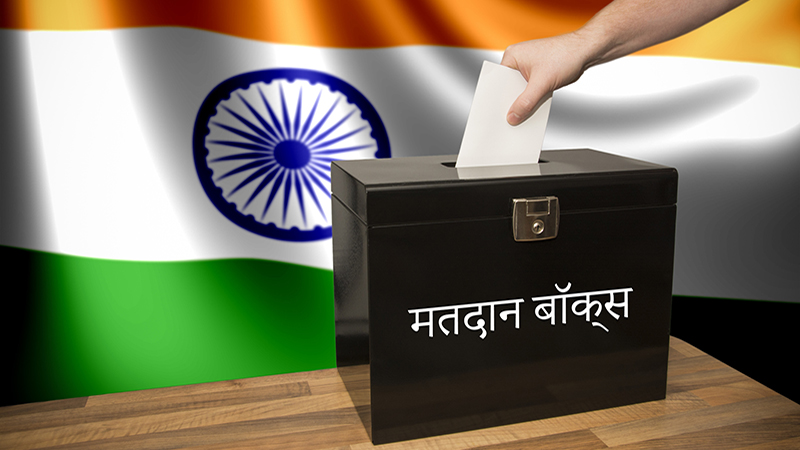India’s marathon general election is set to kick off today (19 April).
Due to the logistics of holding a democratic vote for 968 million eligible voters, the process is spread out over six weeks, meaning official confirmation of the result and vote share won’t come until after the final ballots are placed on 1 June.
While the population will have to wait for the official result, the incumbent Bharatiya Janata Party (BJP), led by prime minister Narendra Modi, is widely expected to secure a comfortable victory.
If re-elected for a third term, Modi has pledged to make India the world’s third largest economy by 2027. So what should foreign investors be looking out for ahead of the election?
Vote share
With most commentators and polls predicting a victory for Modi and BJP, fund managers invested in the region believe the main risk around the election from an investment perspective is around the size of the majority the party may win.
Gaurav Narain, portfolio adviser of the India Capital Growth Fund says: “The Modi-led BJP is expected to win. The main question is how strong would the mandate be? In the previous election in 2019, the BJP won 303 of 543 seats. Their target in this election is 370 seats.
“The closer they reach to 370 the more positively it would be viewed. As the expectation of a BJP victory is already factored in, we see no material impact on the markets or the fund. If the BJP however fares poorly, or does not get a majority, it would be negative for the markets and the fund.”
Chetan Sehgal, lead portfolio manager of the £1.7bn Templeton Emerging Markets Investment Trust (TEMIT) adds: “The vote share matters a lot, because in India some of the seats can swing by a small number of votes. Therefore, typically, the index of opposition unity actually matters in deciding elections. But this time around, even though the opposition seems to be more united, the chances are still in stacked in favour of the BJP.”
See also: Ashoka India Equity proposes share issuance possibly doubling total number of shares
Economic policy
Investors will also take note of any potential change in economic policy, which may have implications for markets. Should the BJP win a third term, however, many believe the government will continue on a similar course of conservative fiscal policy.
TEMIT’s Sehgal notes that it is likely that the focus on conservative fiscal policies will persist. “A two-thirds majority of votes for the BJP and its coalition partners would empower prime minister Modi to make constitutional changes, addressing critical concerns among local businesses and foreign investors. Additionally, there is potential for judicial and economic reforms that could enhance the government’s capacity to generate additional tax revenue.
“Prime minister Modi has dubbed the 2020s as India’s ‘Techade.’ In the short term, he aims to boost domestic demand, while the medium-term focus lies in enhancing export capacity. Negotiations for free trade agreements are underway with the European Union and the United Kingdom. Additionally, the India-Middle East-Europe trade corridor is being developed to leverage tariff-free access to these markets.
“These supply-side policies are equally critical alongside investments in manufacturing capacity, as they contribute to building a sustainable long-term export base in India. Recently, policymakers have emphasized investment in semiconductors to diversify the technology sector’s reliance beyond software services.
“India offers investors a significant growth opportunity given its structural tailwinds, which include attractive demographics, a market-oriented economy, and a rising middle class. These robust growth prospects are, however, reflected in valuations of many securities, which trade at a premium to other emerging markets. We remain selective in companies we invest in and favour companies which have sustainable earnings power and whose share prices are at a discount to our estimate of their intrinsic worth.”
See also: Hawksmoor’s Philbin: We want to be the ‘Intel Inside’ for advisers
India Capital Growth’s Narain adds: “The possible impact of the election outcome on industries lies in the government’s approach to economic policies. The current government has focused on streamlining policies, such as implementing the Goods and Services Tax (GST), which simplifies taxation across the country.
“It is a very transparent policy environment today, reducing the role of politicians in manipulating taxes and promoting a more stable and predictable investment environment. In the past few months, Modi’s been travelling the country every day visiting various cities and inaugurating projects worth billions of dollars – he’s a busy man and his plans for India don’t seem to be slowing down anytime soon. “
“There are a few areas where the current government hasn’t made huge inroads and those will be the next topics of focus post-elections. The Indian legal system, though independent, is very slow, with judgments potentially taking 5-10 years. It is expected that moves will be made to streamline the legal system so that businesses no longer move out of India for arbitration.
“In the labour sector, whilst labour is a state subject, Modi’s whole agenda revolves around his aim for India to be a developed country by 2047, so he needs the per capita income to move up. It is highly likely that there will be a more concerted push for India to become a big manufacturing base.”
Sustainability
In terms of sustainability, Will Scholes, manager of the Premier Miton Emerging Markets Sustainable fund, says he is looking for signals on anything to improve education and health outcomes.
Meanwhile, he also hopes to see support for manufacturing jobs to move people out of agricultural employment, as opposed to the government providing subsidies to farmers.
“That is probably the part of the economy that most worries us,” he says. “India’s successes economically have come with a marked increase in inequality, where the top 1% now have a sufficiently high proportion of total earnings. On that measure, it’s even more unequal than the US. So we’re looking for things that help to address that, and in particular the need for more low end manufacturing jobs.
“The final point is on the inclusion of women. Female participation rates in the workforce are far below the rest of the emerging world. And that’s a drag both for the economy and also for savings rates. Because if you have more women in the workforce, by and large, you do save more. And that’s not just because you’ve got another person in the family unit that’s working, it’s also because you can have fewer children.
“Those are all quite long-cycle policies. I take as read the urban infrastructure reforms, such as water reforms, I’m sure they will still push ahead with that. You don’t need to go to India to see the need for better public transport systems in particular, and urban planning, but I think that in terms of their their intention to become a developed economy that’s taken as read.”
TEMIT’s Sehgal adds: “Efforts are needed to improve female participation in the workforce, upskill workers to facilitate a smoother transition to new employment opportunities, and encourage greater youth engagement.
“Enhancing skills and productivity is essential for India to harness the benefits of its sizable and youthful population.”







